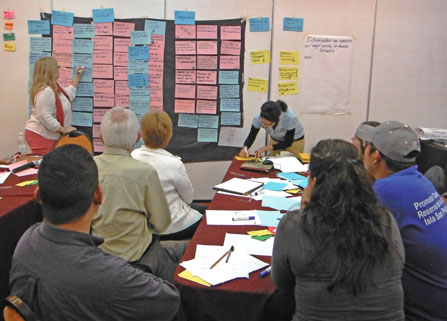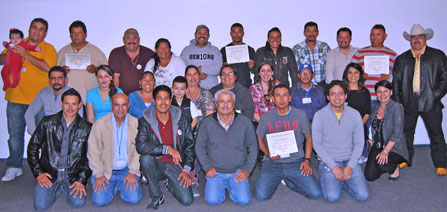New program to help the Gulf of California Islands region address climate change

Ana Luisa Figueroa (left), director of the Gulf of California Islands APFF, leads the workshop Dec. 4-6 that was aimed at defining pilot projects with representatives of local, state and federal governments (Photo: Miriam Nunez).
GUAYMAS
After a year of intensive work developing a plan to help the Midriff Islands region in the Gulf of California to respond to climate change, the project’s architects are calling for greater participation in order to spread the plan throughout the entire gulf region.
In January 2013, the Mexican Fund for Nature Conservation, through its call for proposals for Strategic Innovative Projects, approved the plan titled the “Development of a Program for Adaptation to Climate Change for the Protected Areas of Flora and Fauna in the Gulf of California (Sonora) Mexico Using a Participatory Approach.”
The environmental group Natural Spaces and Sustainable Development (Endesu) and the National Commission on Protected Natural Areas (Conanp) are heading the project through the offices of the Protected Areas of Flora and Fauna (APFF) Gulf of California Islands in Sonora.
The program is designed to help communities act on matters like mitigation, adaptation, communication, coordination, development of pilot field projects and methodological tools. It is also aimed at strengthening institutional and technical capacities, incorporating key players, and meeting institutional regulations.
Ana Luisa Figueroa Carranza, director of the Gulf of California Islands APFF, states that the program wants to bring in other partners in order to jointly develop a regional Program for Adaptation to Climate Change that can analyze the entire region and promote synergy of the three levels of government with other important regional players.
In developing the project, the vulnerability of marine, island, coastal, economic and social environments are to be studied in relation to the APFF’s conservation efforts, beginning with the micro region of the Midriff Islands. The analysis will be conducted using the Atlantis Ecosystem Model, a software program that considers all parts of the marine ecosystem: oceanography, fisheries and food webs in a spatial representation of the study area.
According to its Management Plan, the Gulf of California Islands APFF includes 898 islands offshore of five northwest Mexican states. The area is approximately 1,000 miles long, with a maximum width of almost 127 miles at the latitude of La Paz, BCS and a minimum width of 52 miles near Tiburón Island. Its surface area (including the islands), is estimated at 109,000 square miles.
Because of its enormous size, the Gulf Islands APFF is divided administratively into four sectors: Baja California, Baja California Sur, Sinaloa and Sonora.
The directors of the APFF in Sonora are responsible for the protection of 240 islands along almost 620 miles of coastline. To better manage the area it has been divided into a total of 6 micro regions including the Midriff Islands, the Upper Gulf Region, Guaymas San Carlos, the Yaqui Region, Bay of Tóbari, and Southern Sonora.
Within the Midriff Islands micro region, there are “priority areas” that are located from the northern tip of Isla Angel de la Guarda to Isla San Pedro Mártir, covering the communities of Bahia de Kino, Punta Chueca, El Desemboque and Puerto Libertad in Sonora and the Bahia de Los Angeles and El Barril in Baja California.
The program is using the “Guide for the Preparation of Programs for Adaptation to Climate Change in Protected Areas” prepared by Conanp in 2011 in order to meet its goals in the region.
The guide is a “methodological approach allowing for the development of adaptation strategies aimed at the conservation and sustainable use of ecosystems, biodiversity and the services these habitats provide, as well as the activities of human communities in natural landscapes and different methods of conservation and sustainable use.”
Following the steps detailed in the guide, and with the advice of Foundations of Success, a nonprofit organization committed to working with professionals to improve conservation, thirteen virtual forums were held in 2013. The forums brought together 25 specialists from a variety of institutions and countries and who were experts in the flora and fauna of the region to form marine and terrestrial technical advisory groups.
Three additional workshops were held with approximately 25 attendees. Of these, about fifteen were representatives of the local, state and federal government, including: the Secretariat of Agriculture, Livestock, Rural Development, Fisheries and Food (SAGARPA); the National Institute of Ecology and Climate Change (INECC); the Commission for Ecology and Sustainable Development (CEDES); the government of the State of Sonora; the Mexican Secretariat of the Navy (SEMAR); the Port Captain.; six from the central headquarters and the Gulf of California Islands APFF offices of Conanp in Sonora and Baja California; and the Biosphere Reserve Isla San Pedro Mártir. Four were community representatives of monitoring groups or environmental educators in Bahía de Kino, Sonora. They will all share the responsibility of monitoring the process and evaluating the results of the vulnerability study.

